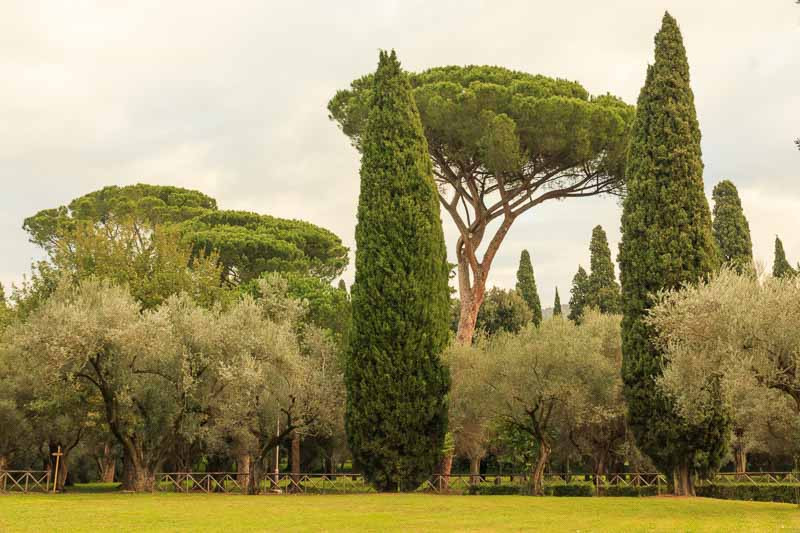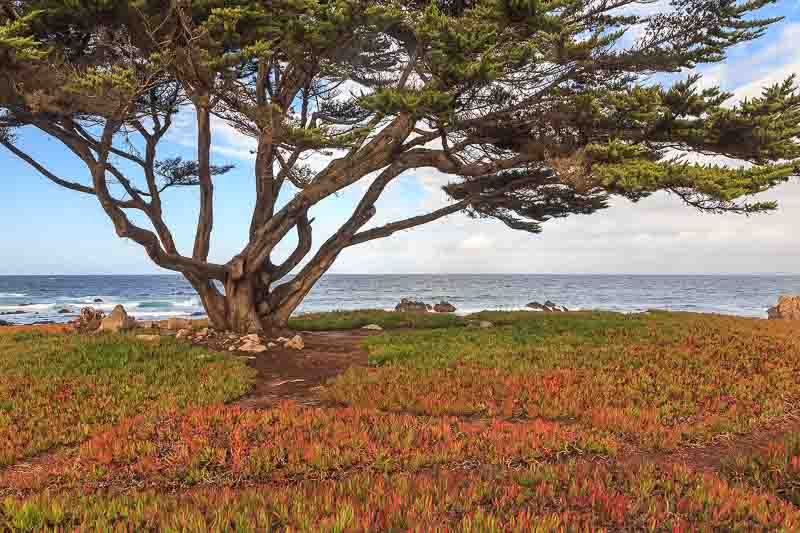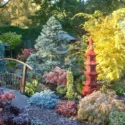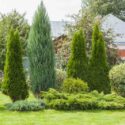Discover the Ideal Cypress Tree for Your Garden and Essential Care Tips

Cypress trees represent a diverse group of coniferous plants within the Cupressaceae family. This broad category includes various species and genera, not only the true cypresses (Cupressus) but also several others that carry ‘cypress’ in their common names. Most trees and shrubs are distinguished by their evergreen foliage, which is typically needle-like in young plants and becomes more scale-like as they mature. Additionally, many cypress species produce distinctive, woody seed cones that resemble acorns in shape and structure.
Diverse Genera: The Cupressaceae family includes various genera, such as Cupressus (true cypresses), Chamaecyparis (false cypresses), and Taxodium (bald cypresses), among others. Each genus has distinct characteristics but shares some common traits associated with cypresses.
Foliage: Many cypress trees have needle-like leaves when young, which may become more scale-like in mature trees. Most are evergreen, providing year-round color and texture in landscapes.
Seed Cones: The seed cones of cypress trees are often woody and can vary in shape and size. Some resemble acorns, while others are more globular or spherical. The cones typically contain multiple seeds and open to release them when mature.
Adaptability and Habitat: Cypress trees can be found in a wide range of environments, from temperate to tropical regions. While some species prefer moist, swampy areas, others are adapted to dry, arid conditions.
Cultural Significance: Beyond their ecological value, cypress trees often hold significant cultural and symbolic meaning in various traditions, symbolizing immortality, mourning, and resilience.
Cupressus arizonica (Arizona Cypress), a resilient and attractive conifer, is known for its blue-green foliage and conical shape. It thrives in arid climates, making it ideal for xeriscaping. It is commonly used for privacy screens, windbreaks, and ornamental purposes, valued for its drought tolerance and distinctive, aromatic wood.
| Hardiness | 7 - 11 |
|---|---|
| Exposure | Full Sun |
| Height |
40' - 60' (12.2m - 18.3m) |
| Spread |
15' - 20' (4.6m - 6.1m) |
Cupressus arizonica var. glabra ‘Blue Ice’, a Smooth Arizona Cypress, is a narrowly columnar evergreen conifer, valued for its striking, silvery gray-blue foliage. The dense, lacy needles, arranged spirally, maintain their frosty hue throughout the year. Growing at a fairly rapid rate of 12 inches annually, ‘Blue Ice’ is notably resilient to intense sun and drought. Its compact, conical shape and stunning color make it an excellent choice for lawns or hedges, adding to its appeal for gardeners and landscapers.
| Hardiness | 6 - 9 |
|---|---|
| Exposure | Full Sun |
| Height |
40' - 50' (12.2m - 15.2m) |
| Spread |
15' - 20' (4.6m - 6.1m) |
Cupressus x leylandii, known as Leyland Cypress, is a fast-growing, evergreen hybrid conifer popular for creating dense privacy hedges. It features a tall, columnar shape with lush green foliage and thrives in a range of soil types, making it a versatile choice for landscaping.
| Hardiness | 6 - 10 |
|---|---|
| Exposure | Full Sun |
| Height |
60' - 70' (18.3m - 21.3m) |
| Spread |
10' - 15' (3m - 4.6m) |
The Monterey Cypress (Cupressus macrocarpa) is a picturesque, fast-growing evergreen conifer. Initially narrow and pyramidal, it matures into a broad, irregular shape. Its lush, dark green foliage remains vibrant year-round, and the tree features striking pale reddish-brown bark that splits into grayish, scaly plates. Native to California’s Central Coast, this species is highly wind-tolerant, with its beauty enhanced by strong winds. It’s widely planted in southern Australia’s coastal areas as a natural windbreak against the vigorous ‘Roaring Forties’ winds, showcasing its robustness and adaptability in harsh conditions.
| Hardiness | 7 - 11 |
|---|---|
| Exposure | Full Sun |
| Height |
40' - 70' (12.2m - 21.3m) |
| Spread |
20' - 80' (6.1m - 24.4m) |
Cupressus macrocarpa ‘Goldcrest’, an award-winning Monterey Cypress, is a columnar evergreen conifer, celebrated for its vibrant golden-yellow foliage arranged in upward sprays. The needles, when crushed, emit a strong lemon scent. This bright foliage maintains its color in winter. Growing rapidly at about 10 inches annually, ‘Goldcrest’ offers a stunning contrast to blue-green conifers in gardens. This Monterey Cypress variant is highly sought after for lawns and hedges due to its striking appearance and aromatic foliage.
| Hardiness | 7 - 11 |
|---|---|
| Exposure | Full Sun |
| Height |
35' - 40' (10.7m - 12.2m) |
| Spread |
12' - 20' (3.7m - 6.1m) |
Prized for its foliage, award-winning Cupressus macrocarpa ‘Wilma’ (Monterey Cypress) is a small, columnar, evergreen conifer boasting a bright golden-yellow foliage in ascending sprays. When crushed the needles smell strongly of lemon. The foliage retains its brilliant color in winter if planted in full sun. The chartreuse foliage of this slow-growing Monterey Cypress (6 in. per year or 15 cm) creates a striking contrast against the ravishing pale reddish-brown bark. A lovely and easy-to-grow specimen, hedge, or container plant. Perfect for small gardens.
| Hardiness | 7 - 11 |
|---|---|
| Exposure | Full Sun, Partial Sun |
| Height |
10' - 12' (3m - 3.7m) |
| Spread |
3' - 4' (90cm - 120cm) |
Cupressus sempervirens, commonly known as the Italian Cypress, is an architectural, long-lived evergreen conifer. Its narrow, columnar form creates an elegant exclamation point in the landscape. The tree features upright branches with green to bluish, scale-like leaves in short flat sprays, aromatic when crushed. Renowned for adding year-round structure, the Italian Cypress is a striking specimen plant, enhancing landscapes with its vertical lines, reminiscent of Tuscan postcards.
| Hardiness | 7 - 9 |
|---|---|
| Exposure | Full Sun |
| Height |
40' - 70' (12.2m - 21.3m) |
| Spread |
10' - 20' (3m - 6.1m) |
Chamaecyparis nootkatensis ‘Green Arrow’, or Nootka Cypress, is a majestic, medium-sized, evergreen conifer with an extremely narrow form. It features weeping branches that bear blue-gray-green foliage, resembling long trailing curtains. Fast-growing, it can add 20 inches annually, making it an excellent, year-round specimen, particularly suitable for small gardens.
| Hardiness | 4 - 8 |
|---|---|
| Exposure | Full Sun, Partial Sun |
| Height |
18' - 35' (5.5m - 10.7m) |
| Spread |
2' - 5' (60cm - 150cm) |
Regarded as a great substitute for dwarf Alberta Spruce, Chamaecyparis pisifera Soft Serve® (Sawara Cypress) is a compact and graceful conifer forming a dense pyramidal, evergreen shrub adorned with soft, fern-like branches. Its bright green, needlelike foliage is adorned with silver-blue flecks on the underside. The foliage keeps its brilliant color year-round, adding drama to the landscape, particularly in winter. Attractive during all seasons, this hardy Sawara Cypress provides unusual texture in the garden and looks charming as a formal accent.
| Hardiness | 4 - 8 |
|---|---|
| Exposure | Full Sun, Partial Sun |
| Height |
6' - 10' (180cm - 3m) |
| Spread |
6' - 10' (180cm - 3m) |
Chamaecyparis pisifera Soft Serve® Gold (Sawara Cypress) is a medium-sized conifer forming a dense pyramidal, evergreen shrub adorned with bright golden foliage. The foliage keeps its brilliant color year-round, adding drama to the landscape, particularly in winter. Attractive during all seasons, this hardy Sawara Cypress provides unusual texture in the garden and looks charming as a formal accent.
| Hardiness | 4 - 8 |
|---|---|
| Exposure | Full Sun, Partial Sun |
| Height |
6' - 10' (180cm - 3m) |
| Spread |
6' - 10' (180cm - 3m) |
Chamaecyparis pisifera ‘Curly Tops’ (Sawara Cypress) is a dense, compact, globose conifer with bright, steel-blue, twisted foliage and branchlets. Its lateral shoots are curled, revealing the white bands of the needlelike leaves which are surprisingly soft to the touch. Slow-growing, this hardy evergreen shrub has an annual growth rate of 1-2 in. (2-5 cm). Remaining attractive all year round, this Sawara Cypress provides unusual texture in the landscape and looks charming in rockeries.
| Hardiness | 4 - 8 |
|---|---|
| Exposure | Full Sun, Partial Sun |
| Height |
1' - 5' (30cm - 150cm) |
| Spread |
1' - 5' (30cm - 150cm) |
Chamaecyparis pisifera ‘Golden Mop’, known as Sawara Cypress, is a dwarf, brightly colored conifer. It forms a globose to conical, evergreen shrub with finely textured, golden-yellow foliage that intensifies in spring. Slow-growing at 1.5-2 inches per year, it adds year-round drama and unique texture, ideal for rockeries and mixed borders.
| Hardiness | 4 - 8 |
|---|---|
| Exposure | Full Sun, Partial Sun |
| Height |
1' - 5' (30cm - 150cm) |
| Spread |
1' - 5' (30cm - 150cm) |
Chamaecyparis nootkatensis ‘Glauca’, or Nootka Cypress, is an incredibly beautiful, tall evergreen conifer. It forms a dense, conical shape with graceful, soft blue-green foliage. In summer, its blue tips contrast with the rest of the foliage, creating a stunning visual effect. Prolific in seed cone production from a young age, this fast-growing variety can add over 12 inches (30 cm) in height and width annually. A year-round delight, this stately Nootka Cypress serves as an excellent specimen conifer, adding elegance and visual interest to any landscape.
| Hardiness | 4 - 7 |
|---|---|
| Exposure | Full Sun, Partial Sun |
| Height |
15' - 25' (4.6m - 7.6m) |
| Spread |
6' - 15' (180cm - 4.6m) |
Chamaecyparis nootkatensis ‘Aurea’, the Nootka Cypress, is a striking evergreen conifer with a slender, pyramidal shape and drooping golden foliage. Initially lemon-yellow in spring, it transitions to yellow-green, adding vibrant color to the landscape. Fast-growing in optimal conditions, it can increase in size by over a foot annually. This elegant tree is a year-round delight, serving as an outstanding specimen conifer.
| Hardiness | 4 - 7 |
|---|---|
| Exposure | Full Sun, Partial Sun |
| Height |
30' - 50' (9.1m - 15.2m) |
| Spread |
8' - 15' (240cm - 4.6m) |
Exuding majesty, Chamaecyparis nootkatensis ‘Pendula’ (Nootka Cypress) is a medium-sized evergreen conifer that showcases a striking weeping form with sweeping, pyramidal branches. Its dark gray-green foliage cascades gracefully, creating an enchanting visual display. This fast-growing selection adds considerable height and width each year, making it a captivating specimen conifer for year-round enjoyment.
| Hardiness | 4 - 7 |
|---|---|
| Exposure | Full Sun, Partial Sun |
| Height |
20' - 35' (6.1m - 10.7m) |
| Spread |
8' - 12' (240cm - 3.7m) |
Chamaecyparis obtusa ‘Nana Gracilis’ (Hinoki Cypress), a top dwarf conifer, is a slow-growing evergreen that forms a dense, globe-like shape, evolving into a broader conical form. It features glossy dark green foliage in short, shell-like sprays, growing 3-6 inches yearly. With green-to-reddish brown cones, this 1867-introduced cultivar is ideal for sunny borders, rock gardens, or containers, providing year-round color and structure.
| Hardiness | 4 - 8 |
|---|---|
| Exposure | Full Sun |
| Height |
3' - 6' (90cm - 180cm) |
| Spread |
2' - 4' (60cm - 120cm) |
Quite showy, Chamaecyparis obtusa ‘Fernspray Gold’ (Hinoki Cypress) is a medium-sized, upright, evergreen shrub with a gracefully irregular, pyramidal habit. The arching to horizontal branches are densely clothed in flat sprays of fern-like foliage. Golden-yellow in full sun, the foliage becomes greener towards the interior of the plant. The typical growth rate is 6-8 in. per year (15-20 cm). A pleasure to look at year-round, this attractive Hinoki Cypress is perfect for sunny borders or rock gardens.
| Hardiness | 4 - 8 |
|---|---|
| Exposure | Full Sun, Partial Sun |
| Height |
5' - 6' (150cm - 180cm) |
| Spread |
2' - 3' (60cm - 90cm) |
Chamaecyparis obtusa ‘Kamarachiba’ (Hinoki Cypress) is a low-growing, spreading, evergreen shrub with flat sprays of golden-green, lacy foliage in summer, turning golden yellow in winter. Slow-growing, this attractive cultivar is perfect for sunny borders, rock gardens, or containers where it adds year-round color and structure.
| Hardiness | 4 - 8 |
|---|---|
| Exposure | Full Sun |
| Height |
1' - 2' (30cm - 60cm) |
| Spread |
2' - 3' (60cm - 90cm) |
An old cultivar that originated in Japan long ago, Chamaecyparis obtusa ‘Pygmaea’ (Hinoki Cypress) is a compact, dwarf conifer forming a flat-topped, rounded, evergreen shrub with spreading branches and fan-shaped sprays of glossy green foliage than turns bronze-olive in winter. The leaves are bright green in summer, providing a lovely contrast with the red-brown stems. The typical rate of growth is 2-3 in. (5-7 cm) per year. This Hinoki Cypress is perfect for sunny borders, rock gardens or containers where it adds year-round color and structure.
| Hardiness | 4 - 8 |
|---|---|
| Exposure | Full Sun, Partial Sun |
| Height |
2' - 3' (60cm - 90cm) |
| Spread |
4' - 5' (120cm - 150cm) |
Providing year-round color and structure, Chamaecyparis lawsoniana Pinpoint® Blue is a lovely, evergreen conifer forming a medium-sized, narrow columnar shrub with lush and soft feathery sprays. Emerging blue-green, the foliage looks beautiful year-round and is exceptional in spring. Perfect for small gardens, this Lawson Cypress makes a wonderful specimen plant, adds accent vertical lines to the landscape and is perfect for hedges and screens.
| Hardiness | 5 - 7 |
|---|---|
| Exposure | Full Sun, Partial Sun |
| Height |
6' - 8' (180cm - 240cm) |
| Spread |
5' - 6' (150cm - 180cm) |
Providing year-round color and structure, Chamaecyparis lawsoniana Pinpoint® Blue & Gold is a lovely, evergreen conifer forming a medium-sized, narrow columnar shrub with lush and soft feathery sprays. Emerging deep green with golden tips, the foliage looks beautiful year-round and is exceptional in spring. Perfect for small gardens, this Lawson Cypress makes a wonderful specimen plant, adds accent vertical lines to the landscape and is perfect for hedges and screens.
| Hardiness | 5 - 7 |
|---|---|
| Exposure | Full Sun, Partial Sun |
| Height |
6' - 8' (180cm - 240cm) |
| Spread |
5' - 6' (150cm - 180cm) |
Sparkling like a jewel in the garden, Chamaecyparis lawsoniana ‘Minima Silver Threads’ (Lawson Cypress) is a dwarf, evergreen shrub of narrow pyramidal habit, with green needlelike foliage adorned with white and golden flecks. Slow-growing, 2-4 in. (5-10 cm) per year, the small stature of this attractive Lawson Cypress makes it perfect for small gardens where it adds year-round color and structure.
| Hardiness | 5 - 8 |
|---|---|
| Exposure | Full Sun, Partial Sun |
| Height |
3' - 5' (90cm - 150cm) |
| Spread |
2' - 3' (60cm - 90cm) |
Highly popular, Chamaecyparis lawsoniana ‘Minima Glauca’ (Lawson Cypress) is a dwarf, evergreen shrub of broadly globose habit, with lush, densely arranged, vertical sprays of soft blue-green foliage. Slow-growing, 2-3 in. (5-7 cm) per year, the small stature of this attractive Lawson Cypress makes it perfect for sunny borders, rock gardens, or containers where it adds year-round color and structure.
| Hardiness | 5 - 8 |
|---|---|
| Exposure | Full Sun, Partial Sun |
| Height |
2' - 3' (60cm - 90cm) |
| Spread |
1' - 2' (30cm - 60cm) |
Highly popular, Chamaecyparis lawsoniana ‘Minima Aurea’ (Lawson Cypress) is a dwarf, evergreen shrub of conical habit, with dense, stunning, golden-yellow foliage ascending in flat sprays. Its brilliant color is at its best when grown in a sunny location. Slow-growing, 1-6 in. (2.5-15 cm) per year, the small stature of this attractive Lawson Cypress makes it perfect for sunny borders, rock gardens or containers where it adds year-round color and structure.
| Hardiness | 5 - 8 |
|---|---|
| Exposure | Full Sun, Partial Sun |
| Height |
1' - 3' (30cm - 90cm) |
| Spread |
1' - 2' (30cm - 60cm) |
Highly decorative, Chamaecyparis lawsoniana ‘Ellwoodii’ (Lawson Cypress) is an upright, evergreen shrub of dense columnar habit with short sprays of soft feathery, silver-blue foliage, turning steel-blue in winter. Slow-growing, 1-6 in. (2.5-15 cm) per year. Very versatile, it is a popular choice in a number of gardens. Adding year-round structure, it makes a wonderful specimen plant, adds vertical accent lines to the landscape, and is perfect for hedges and screens.
| Hardiness | 5 - 8 |
|---|---|
| Exposure | Full Sun, Partial Sun |
| Height |
13' - 20' (4m - 6.1m) |
| Spread |
5' - 8' (150cm - 240cm) |
Regarded as the bluest of the Lawson Cypress cultivars, Chamaecyparis lawsoniana ‘Pembury Blue’ is a majestic, evergreen conifer forming a medium-sized, broadly conical tree. Its elegant, pendulous sprays of bright silvery-blue foliage scream for attention all year long. It is of moderate growth, 6-12 in. (15-30 cm) per year. A popular choice in a number of gardens, this cultivar is ideal for providing a year-round structure. It makes a wonderful specimen plant, adds accent vertical lines to the landscape, and is perfect for hedges and screens.
| Hardiness | 5 - 8 |
|---|---|
| Exposure | Full Sun, Partial Sun |
| Height |
8' - 10' (240cm - 3m) |
| Spread |
4' - 5' (120cm - 150cm) |
Chamaecyparis pisifera ‘Filifera Aurea’ (Sawara Cypress) is a sought-after evergreen shrub with gracefully weeping golden foliage. Its open habit and cord-like foliage create a stunning visual contrast. With attractive cones and year-round appeal, it adds unique texture to landscapes and shines in rockeries. A hardy and captivating choice for any garden.
| Hardiness | 4 - 8 |
|---|---|
| Exposure | Full Sun, Partial Sun |
| Height |
6' - 20' (180cm - 6.1m) |
| Spread |
3' - 7' (90cm - 210cm) |
Chamaecyparis thyoides, known as Atlantic White Cedar, is a dense, columnar evergreen conifer with short, ascending branches. It showcases attractive blue-green, needle-like juvenile leaves and scale-like adult foliage. Native to freshwater swamps along the East Coast, it’s a year-round visual delight. Remarkably resistant to serious diseases and pests, including apple-cedar rust, this stately tree excels in wet, poorly drained areas.
| Hardiness | 3 - 8 |
|---|---|
| Exposure | Full Sun, Partial Sun |
| Height |
30' - 50' (9.1m - 15.2m) |
| Spread |
12' - 15' (3.7m - 4.6m) |
Taxodium distichum, known as the Bald Cypress, is a long-lived, deciduous conifer famous for its feathery foliage, buttressed trunk, and distinctive ‘knees.’ It thrives in wet conditions, often found in southern U.S. swamps, and is valued for its rot-resistant wood and unique, picturesque appearance.
| Hardiness | 5 - 11 |
|---|---|
| Exposure | Full Sun, Partial Sun |
| Height |
50' - 70' (15.2m - 21.3m) |
| Spread |
20' - 30' (6.1m - 9.1m) |
Taxodium ascendens, or Pond Cypress, is a versatile and wind-tolerant deciduous conifer, adding great beauty to various landscapes with its narrowly conical or columnar shape. Unlike most conifers, it sheds its needles in winter and regrows them in spring. The delicate foliage, composed of soft, bright green, awl-shaped leaves, transforms into rich orange, cinnamon, and golden-brown hues in autumn before falling, revealing the tree’s light brown, ridged bark. Notably, when grown in waterlogged soils, its trunk develops distinctive ‘knees’. Long-lived and with exceptional ornamental qualities, Pond Cypress is an ideal choice for stream banks or pond edges, yet it also thrives in dry locations.
| Hardiness | 5 - 10 |
|---|---|
| Exposure | Full Sun, Partial Sun |
| Height |
50' - 60' (15.2m - 18.3m) |
| Spread |
10' - 15' (3m - 4.6m) |
Taxodium mucronatum (Montezuma Cypress) is a graceful coniferous tree with strongly weeping branches. Pyramidal when young with a dense crown, it eventually develops into a broad-topped, spreading, open tree when mature. Its foliage of pale green, needle-like leaves is evergreen in mild climates but is partially or wholly deciduous in cold areas, turning dull gold in fall. The trunk grows unusually thick toward the base, even on young trees. Long-lived, Montezuma Cypress is the national tree of Mexico. A beautiful tree for large lawns.
| Hardiness | 8 - 11 |
|---|---|
| Exposure | Full Sun |
| Height |
50' - 80' (15.2m - 24.4m) |
| Spread |
25' - 35' (7.6m - 10.7m) |
When choosing and buying a cypress tree, several factors must be considered to ensure you select a tree that will thrive in your landscape and meet your aesthetic needs. Here are some key points to guide you:
Determine the Right Species: Cypress trees come in various species with unique characteristics. Consider your area’s climate and soil conditions, as well as the space available for the tree to grow. Some popular species include Leyland cypress for fast growth and privacy screens, bald cypress for wet areas, and Mediterranean cypress for tall, narrow growth.
Consider the Purpose: Consider why you want a cypress tree – for privacy, ornamental purposes, or perhaps for a specific spot in your garden. This will influence the species and size you choose.
Size and Maturity: Decide whether you want a young sapling that you can watch grow or a more mature tree for immediate impact. Remember that mature trees are more expensive and require more care during planting.
Health of the Tree: Look for a tree with vibrant green foliage. Avoid trees with brown, yellowing, or sparse needles, indicating poor health. Check for signs of pests or diseases, like unusual spots on leaves or bark.
Root System: If possible, examine the root system. It should be well-developed but not pot-bound (roots circling tightly in the container). A healthy root system is critical for the tree’s growth and establishment.
Buy from Reputable Sources: Purchase your tree from a reputable nursery or garden center. They can provide healthy plants and often offer guidance on how to care for them.
Transport and Planting: Plan how you’ll transport and plant the tree. Larger trees might require professional assistance. The best time to plant cypress trees is in the fall or early spring.
Aftercare Requirements: Understand the aftercare needs of your chosen species, including watering, fertilizing, and pruning requirements.

Growing and caring for cypress trees involves understanding their specific needs and providing the right conditions for them to thrive. Here’s a comprehensive guide:
Selecting the Right Location:
Soil Preparation:
Planting:
Watering:
Fertilizing:
Pruning:
Pest and Disease Management:
Mulching:
Winter Care:

What is special about cypress trees?
Cypress trees are prized for their tall, slender, and often conical shape. Their evergreen foliage, which can be needle-like or scale-like, remains lush throughout the year. They are often long-lived, with some species living for hundreds of years. Many cypress species are adaptable to various environmental conditions, from wet, marshy areas to dry, rocky landscapes.
Why is the cypress tree a symbol of death?
With its tall, slender form and evergreen foliage, the cypress tree has long been a symbol of mourning and death. Historically used in funerary practices and commonly found in graveyards, its enduring greenery represents eternal life amidst death, embodying themes of mourning, the afterlife, and the soul’s journey to heaven.
What is the most popular cypress tree?
The Leyland Cypress (x Cupressocyparis leylandii) is the most popular cypress tree, especially for landscaping. Its rapid growth rate, dense, evergreen foliage, and adaptability to various soil types make it a top choice for privacy hedges and windbreaks, offering quick, effective screening and aesthetic appeal in residential and commercial settings.
Which cypress tree grows fastest?
The Leyland Cypress (x Cupressocyparis leylandii) is renowned for being the fastest-growing cypress tree. It can grow an impressive 3 to 4 feet annually, making it a highly sought-after choice for creating quick privacy screens or hedges in landscaping. Its rapid growth and dense, attractive foliage contribute to its widespread popularity.
What is the most drought-tolerant cypress tree?
The Arizona Cypress (Cupressus arizonica) is highly regarded for its exceptional drought tolerance. This cypress species thrives in arid conditions, making it ideal for xeriscaping and landscapes in dry regions. Its attractive blue-green foliage and adaptability to poor, rocky soils further enhance its appeal in drought-prone areas.
What is the lifespan of a cypress tree?
The lifespan of a cypress tree varies by species, but many can live for hundreds of years. Some, like the Mediterranean Cypress (Cupressus sempervirens), are known to live for over a thousand years. Their longevity, combined with evergreen foliage and stately growth, makes them timeless additions to landscapes and gardens.
From roses to sunflowers and daisies to tulips, learn about the types of flowers and their unique characteristics.
Despite the myth that orchids are fussy and difficult to grow, many orchids are not as delicate as most people think. They can adapt to the temperatures and light conditions found on the average home windowsill and be rewarding indoor plants. Many orchids are winter bloomers, which makes them even more desirable as houseplants.
Despite their reputation for being difficult, many orchids can be easily grown as houseplants. Most have been bred to be compact and easy to grow and flower on window sillls and under artificial light. Without requiring much care, they can bloom every year, or even several times per year.
Planting an oak tree offers numerous benefits: it provides a vital habitat and food source for wildlife, significantly sequesters carbon to combat climate change, improves air quality by filtering pollutants, enriches soil health through its leaf litter, and aids in water conservation with its extensive root system.
Crafting an enchanting hedge in your garden is a rewarding endeavor. Hedges serve as living boundaries, offering privacy, beauty, and structure. Explore a world of possibilities with various shrubs, each contributing its unique charm to create the hedge that suits your landscape vision.
Native shrubs for shade offer a natural, low-maintenance solution to beautify shaded garden areas. They thrive with minimal care, support local wildlife, and maintain ecological balance. Ideal for under tree canopies or north-facing gardens, these shrubs add color, texture, and year-round interest while fostering a healthy, biodiverse landscape.
Enhance your garden with flowering shrubs that love the sun! These vibrant, sun-loving plants bring color, fragrance, and life, even in the brightest spots. Ideal for creating dynamic landscapes, they offer varied blooms and sizes, perfect for any garden seeking a burst of color and natural beauty.
Create a garden that commands attention throughout the year by selecting trees that excite interest month after month and provide a ravishing show throughout all four seasons.
Want to learn how to grow and care for Jade Plants like a pro? Follow these simple steps and enjoy the beauty of these charming plants.
Want to learn how to grow and care for Caladium like a pro? Follow these simple steps and enjoy the beauty of these striking plants
To attract butterflies to your garden, plant a variety of nectar-rich flowers and host plants for caterpillars. Choose colorful, fragrant blooms and include native species. Provide sunny, sheltered spots for basking, along with a water source. Avoid pesticides to ensure a safe habitat for these delicate, pollinating insects.










Create a membership account to save your garden designs and to view them on any device.
Becoming a contributing member of Gardenia is easy and can be done in just a few minutes. If you provide us with your name, email address and the payment of a modest $25 annual membership fee, you will become a full member, enabling you to design and save up to 25 of your garden design ideas.
Join now and start creating your dream garden!
Create a membership account to save your garden designs and to view them on any device.
Becoming a contributing member of Gardenia is easy and can be done in just a few minutes. If you provide us with your name, email address and the payment of a modest $25 annual membership fee, you will become a full member, enabling you to design and save up to 25 of your garden design ideas.
Join now and start creating your dream garden!